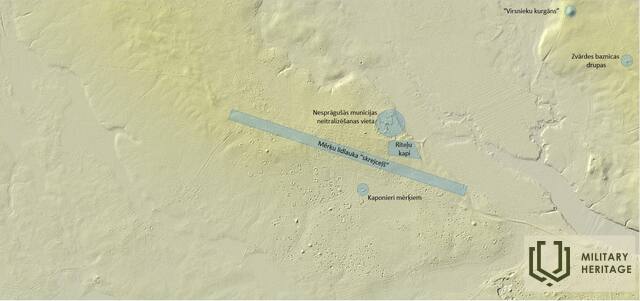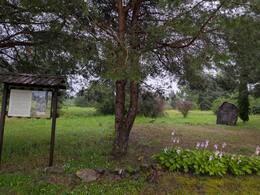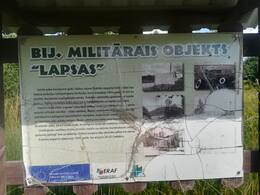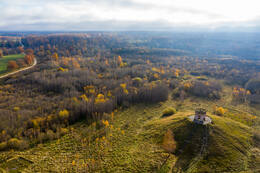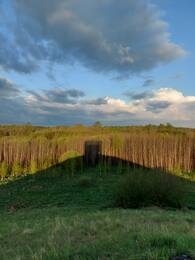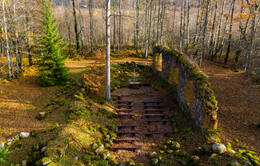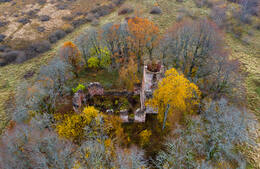Soviet aircraft bomb Riteli Cemetery
The Riteli cemetery was actually located in the centre of the target area. The locals could only watch as they were destroyed.
"The Riteli cemetery was actually in the centre of the target area. The locals had no choice but to watch them being destroyed. Bombs often strayed from their targets, falling in the open fields, in the forest and in Lake Svētaiņi. The Ryteliai cemetery was also destroyed - I myself saw human bones thrown there... We were allowed to give the broken trees for firewood, but very few of them were taken. Why? It was very difficult to saw such trees, and dangerous to burn firewood. I also had an explosion in the stove fireplace when I was burning firewood here: coals and splinters on the floor, but the stove jumped and flew!"
3D model of Zvarde landfill:
https://sketchfab.com/3d-models/zvardes-merkpoligons-4c93587aba324c22b1fd7b027e184a50
Related timeline
Related topics
Related objects
Morning Cemetery
After the airfield was established in this area in 1953 at the request of the USSR Ministry of Defence, the Zvārde Church, the Ķerkliņi Church and the Rīteļi Cemetery were actually located in the centre of the airfield - next to an artificial airfield with access roads and defence positions, which was used as a target by Soviet pilots. Planes flew here from airfields in Latvia and elsewhere in the Soviet Union. In less than 40 years, the church, the cemetery, the former manor house and dozens of surrounding buildings were reduced to ruins. Today, the site is cared for by the Saldus Martin Luther Church. The surrounding area is still contaminated with unexploded ordnance and it can be dangerous to walk off the roads.
Barbarism reached its peak in 1988, when the Rīteļi cemetery with its graves and monuments was bulldozed.
On 21 July 1990, in one of the first actions in which the Latvian population demanded that the USSR army leave the territory of Zvārde, a protest rally was held in Saldus, after which people went to the Rīteļi cemetery. The rally participants were allowed into the landfill site, and they cleaned up the cemetery a bit and dug white crosses.
The landfill continued to be used until 1992 and even as late as March 1992 a plane taking off from Lielvārde crashed in the landfill for unknown reasons. The Latvian Defence Forces started demining the site in May 1993, after the withdrawal of the Russian army. In 2008, Zvārde residents installed a memorial stone "Forgive us for not saving you" in the Rīteļi cemetery.
Zvārde shooting range and former Soviet military base "Lapsas"
The landfill's service base is located approximately 2 kilometres east of Striķu Manor, on the Saldus-Auce road. The former Soviet Military Aviation Target Range (military unit No 15439) in Zvārde is located south of Saldus. The territory of the airfield is home to several sights - the ruins of Zvārde and Ķerkliņi churches, the ruined Rīteļi cemetery, the observation post of the airfield, the so-called "Officers' Kurgan" and the former airfield personnel base and shooting range "Lapsas".
The Zvārde air target range required a unit of approximately one company to service the air target range - to install targets, repair damage, guard the air target range and coordinate air flights. It was based on the site of the house called "Lapsas" until the Second World War. With the construction of the airfield, barracks, transport sheds, a flight control tower and a firing range for training personnel were built.
After Latvia regained its independence, the Zvārde Defence Forces Training Centre operated here, but since 2007 the site has been owned by the municipality and leased by several hunting collectives. The former barracks house an exhibition on the history of Zvārde parish.
Soviet Army Observation Tower (Kurgan of Officers)
The "Officers' Kurgan" is located less than a kilometre from the ruins of Zvārde Church. The Kurgan is made of the ruins and remains of the surrounding houses and manor house, which have been bulldozed together. An observation tower was built on the kurgan. According to the inscription, the present tower was built in 1981. The tower was used to record bomb hits. The training bombs had a reduced explosive content, so their hits had to be watched more carefully. Unexploded bombs were neutralized immediately, but not all could be found.
The remains of the tower can be seen here today - the brick walls. As the barrage is relatively high, you can even see the Lithuanian oil refinery in Mažeikiai on a clear day.
Soviet air force target firing ground in Zvārde
Zvārde landfill is located in Zvārde municipality, Saldus region. It is a former military aviation training ground of the USSR, covering more than 24 000 hectares.
The territory of the former airfield is home to several sites: the Officers' Kurgan, the ruins of the Zvārde and Ķērkliņi churches, the Rīteļi cemetery, the former army base "Lapsas", and others. Until the Second World War, the site of the observation tower was home to the "Vairogi" house. During the construction of the polygon, what was left of the farm - walls, the remains of the apple orchard, and part of the ruins of the Veczvārde manor - was piled together to form a mound and the observation tower was built on it. It was used as an observation point for coordinating the army's training manoeuvres. This place is popularly known as Kurgan. The mound overlooks the former training ground and the wooded areas of Zvārde Nature Park and Nature Reserve. A good place for bird watching. The surroundings of Kurgāns are not landscaped.
Zvārde church ruins
The ruins of Zvārde Church are located on the territory of the former Zvārde air target range, near the so-called "Kurgan of the Officers". After a kilometre and a half, you will pass a T-junction with the Rīteļi cemetery nearby.
The first wooden church and rectory were built here in 1567, and the stone church was built in 1783 at the expense of local peasants, Kurzeme nobles and Duke of Courland Peter Byron. During the Second World War, the church roof and tower were damaged in the fighting. In 1953, when the Soviet Ministry of Defence requested the establishment of an air-target range on the site, Zvārde Church, Ķerkliņi Church and Rīteļi Cemetery were placed in the centre of the air-target range - next to an artificial airfield with access roads and defensive positions, which was used as a target by Soviet pilots. Planes flew here from airfields in Latvia and elsewhere in the Soviet Union. In less than 40 years, the church, the cemetery, the former manor house and dozens of surrounding buildings were reduced to ruins.
Ruins of Ķērkliņu church
The ruins of the Ķerkliņu Church are located about 5 kilometres north-west of Kokmuiža, near the Ķerkliņu Lake. The church was built in 1641 by Heinrich von Dönhoff (Derkarth), the owner of the Ķerkliņi manor. The original wooden church was replaced by a stone building, under which tombs were built for the dead of the Dönhof and later Kleist families. The tombs were already destroyed during the 1905 riots, but in 1949 the coffins were moved from the tombs to the church. The church was an example of the Kurzeme Baroque style - its carvings were made by the Kuldīga - Liepāja woodcarvers. Although the owners of the manor and the church were at various times plagued by financial problems, the church underwent several reconstructions during its existence. It also suffered during the First World War, after which the parish rebuilt the stonework in 1929 and added an organ in 1934. Unfortunately, the church was damaged during the Second World War and much of it was lost, so it is to be commended that before the church was rebuilt in 1933, many unique pieces of Baroque sculpture were photographed, inventoried and even ended up in the archives of the Monuments Board. With the establishment of the landfill and the eviction of the inhabitants, the church was never restored. Today, the church walls and tower are visible.





